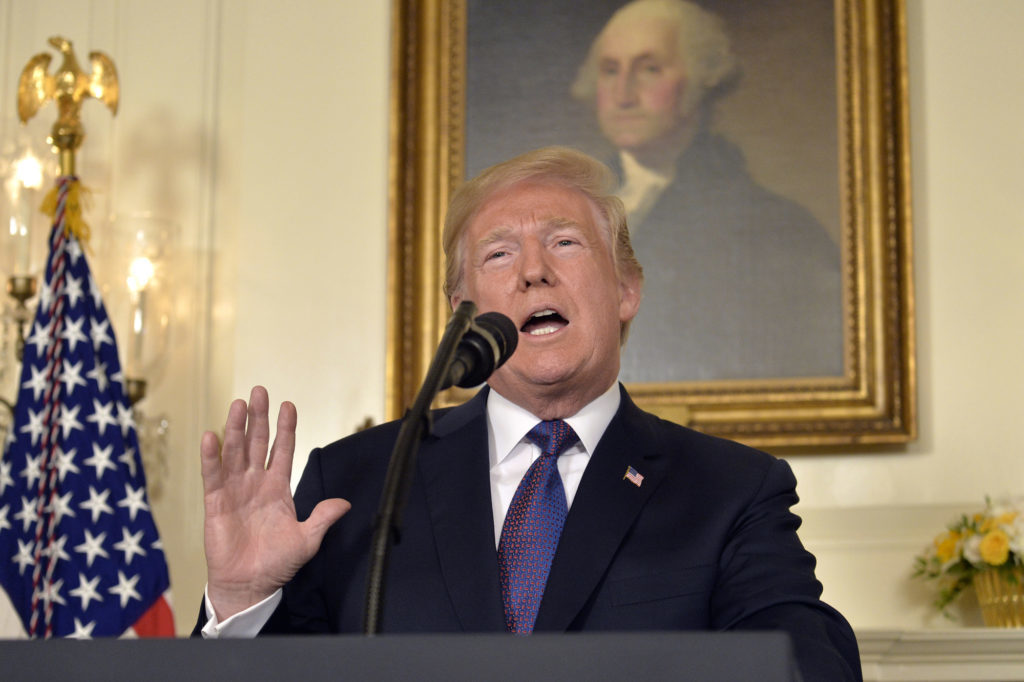
Oil rebounded to trade at the highest level since 2014 as investors focused on how buyers of Iranian crude will react to U.S. sanctions aimed at cutting exports from OPEC’s third-largest producer.
Futures advanced more than 2 percent after U.S. President Donald Trump confirmed his withdrawal from a 2015 deal that had eased sanctions on Iran in exchange for curbs on its nuclear program. While futures settled lower on Tuesday, having risen through the previous week in the run-up to widely anticipated announcement, they rallied in after-hours trade and into the Asian morning.
The U.S. is seeking to cut Iran’s exports once again, giving buyers 180 days to reduce purchases from the Islamic Republic. While industry watchers including FGE have said the measures may curb the OPEC member’s production, Barclays Plc sees output little changed. MUFG Bank said nations such as China, India and Turkey may oppose America’s move, while Saudi Arabia promised to work with other OPEC members to “mitigate” the impact.
“The market had pretty much priced in the likelihood that President Trump would pull out of the deal,” said Daniel Hynes, a senior commodities strategist at Australia & New Zealand Banking Group Ltd. “However, there is still plenty of ambiguity, so investors are taking a wait and see approach now.”
U.S. West Texas Intermediate oil for June delivery rose as much as 2.4 percent to $70.72 a barrel on the New York Mercantile Exchange and traded at $70.64 at 1:06 p.m. Singapore time. Prices settled 2.4 percent lower on Tuesday, retreating from the highest close since 2014. Total volume traded Wednesday was about 36 percent above the 100-day average.
Brent for July settlement climbed as much as 2.5 percent to $76.75 a barrel on the London-based ICE Futures Europe exchange. Futures slid 1.7 percent to $74.85 a barrel on Tuesday. The global benchmark crude traded at a $6.12 premium to July WTI.
Futures for September delivery on the Shanghai International Energy Exchange rose 1.5 percent to 465.8 yuan a barrel, climbing for a third day. Volumes for the contract are at the highest level since trading began on March 26.
The sanctions “effectively” go into place immediately, U.S. Treasury Secretary Steven Mnuchin said after Trump announced the withdrawal. In a document accompanying the announcement, the Treasury Department gave an unequivocal “Yes” to the question of “Will the United States resume efforts to reduce Iran’s crude oil sales?”
The U.S. once again left the door open for countries to seek “significant reduction exceptions” at the end of the 180-day period if they reduce the volume of purchases during that time.
Japan was one of the first countries to confirm that it will seek a waiver. The country plans to find out whether its current import volume is enough to get an exception or whether it needs to further reduce purchases, Takashi Yamada, director of petroleum policy at Ministry of Economy, Trade and Industry, said by phone. The nation bought 177,000 barrels a day from Iran in 2017, lower than levels before previous sanctions were imposed, he said.
While Saudi Arabia, which is said to be aiming for oil at about $80 a barrel, said it’s ready to minimize the effect of sanctions on the market, the world’s largest crude exporter didn’t say whether it would boost output.
“I don’t think Saudi Arabia or OPEC will step in and contain prices at the moment,” sid Hynes. “I don’t think we are near those levels when it will act. I suspect they want to see $80 a barrel.”
French President Emmanuel Macron, who personally lobbied Trump to remain in the nuclear deal during a state visit to Washington last month, said on Twitter that “France, Germany, and the UK regret the U.S. decision to leave the JCPOA,” using an acronym for the agreement. The U.S. withdrawal was intended to force Iran to renegotiate an pact the country’s leaders have said they will not revisit.
Speculation in the run up to Trump’s decision had lifted oil over the past month, helped overshadow concerns about whether rising U.S. supplies will undermine glut-shrinking output curbs by the Organization of Petroleum Exporting Countries and allies including Russia.
Prices were also helped on Tuesday after the American Petroleum Institute was said to report a 1.85 million-barrel drop in nationwide crude stockpiles last week. The oil hoard likely increased by 1 million barrels last week, according to the median estimate of analysts surveyed by Bloomberg ahead of the release of government data on Wednesday.
“In the short term, the U.S. withdrawal can add to volatility in prices as there are speculative positions in place, seeking to yield profit,” said Lim Jaekyun, a commodities analyst at KB Securities Co. “However, in the long term, fundamentals are still looking healthy, so I don’t see a reason to worry.”
Recommended for you
